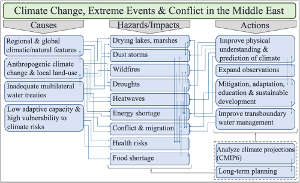Understanding longevity: From gene sequences to social inequity
03 April 2025
Published online 28 April 2023
Amin Dezfuli, a hydrometeorologist at NASA’s Goddard Space Flight Center and the University of Maryland Baltimore County, outlines a framework for short- and long-term environmental planning.

In 2021, Iran and other parts of the Middle East experienced record hot and dry conditions that can historically jointly occur about every 150 years. Inadequate policies and unpreparedness for mitigating the impacts of such conditions contributed to energy and water shortages across the region. Such conditions may be exacerbated in the coming decades, and a new, effective governing approach is needed to mitigate future domestic and transboundary water issues with an emphasis on environmental justice.
Here, a decision-making framework is introduced to identify the knowledge and management gaps and offer solutions for short- to long-term environmental planning.
Climate conditions in 2021
Most people in the Middle East are at risk of being affected by climate-related hazards, such as prolonged droughts, dust storms, heavy floods and heatwaves. The increasing trend of these hazards in recent decades has caused serious environmental issues in each country and exacerbated regional geopolitical conflicts, such as those attributed to the Southeastern Anatolia Project known as GAP, the largest hydropower and irrigation development in the region.
The scale and societal consequences of climate change impacts in the region were exceptionally large in 2021. A large part of the region experienced extreme high temperatures (≥95th percentile) in early summer and low precipitation (< 5th percentile) in the preceding winter/spring, relative to their long-term mean over the period from 1981 to 2020 (Fig. 1A).

Amin Dezfuli (2023)
Enlarge image
Socio-environmental consequences across the region
These compounding effects sparked a range of socio-environmental crises and widespread protests across the region, including in Iran, Iraq, Syria, and Lebanon. The unrest that escalated in mid-July 2021 was triggered by water shortages that financially distressed farmers and significantly restricted access to drinking water for people and livestock. More than 12 million people in Syria and Iraq and 300 towns and cities in Iran were affected by drought, which caused 50-70% decline in wheat production in areas like the Kurdistan Region of Iraq. In addition, an increase in energy demand due to higher temperatures, combined with a decrease in electricity supply due to reduction of water storage in hydropower plants resulted in frequent blackouts during the record hot summer. For example, the power consumption in Iran exceeded the country’s production capacity by 11 gigawatts, and the energy crisis forced people in Lebanon to almost fully rely on generators during the hot days of July. It is likely that socio-economic stress imposed by the COVID-19 pandemic restricted an effective response by the authorities to these compound climate extremes and therefore their impacts were exacerbated.
The consequences of extreme hydroclimatic conditions once again drew attention to the controversial transboundary water conflicts in the region. For example, Turkey and to a lesser degree Iran, who control the headwaters of the Tigris and Euphrates rivers, tremendously reduced the water flow to Iraq, which relies on these rivers for nearly all its freshwater needs. Electricity export from Iran to Iraq was nearly zero in June 2021 due to Iran’s own domestic supply crisis and unpaid bills by the Iraqi government. Turkey, in turn, had its own share of challenges. The hot-dry conditions facilitated the spread of unprecedented wildfires in the southern part of the country. Ironically, devastating floods happened in northern Turkey, underlining the fact that heavy floods can happen in both wet and dry years.
A regional framework connecting hazards, causes and actions
The number and variety of regional consequences of climate extremes within just a few months is remarkable. However, it is quite unlikely that 2021 will be the last record-breaking year of compound extreme conditions and, except for a few oil-rich Arab countries and Israel, the region is not well-prepared to cope with the next one. In particular, Iran, Iraq and Syria, which were located in the most affected region during the 2021 extreme climate, have very low adaptive capacity and medium to high vulnerability to climate risks.

Amin Dezfuli (2023)
Enlarge image
Most hazards have multiple drivers, which may be a combination of natural climate variability, policies, human-induced external forcing factors like global warming and land-use change, and other climate hazards.
The contribution of domestic and regional political triggers to hazards can be as important as factors related to the earth system. For example, the lack of reliable multilateral agreements on the Tigris-Euphrates water resources has been a major cause of conflict among riparian countries, particularly during droughts, which are projected to be more frequent in the future. Prolonged droughts will intensify the shortage of food, drinking water, and energy, resulting in intra- and inter-state climate migration that could pose a threat to regional and global security.
Another aspect of climate impacts pertains to health risks, such as heatwaves, air pollution due to enhanced dust emissions and wildfires, deteriorated water quality, and an increase in vector-borne diseases, like malaria, due to warming temperatures and expansion of hydropower development.
Future directions
These are just a few examples of how different parts of society and the ecosystem may be affected by climate change and extremes in the region. This brief note does not intend to fully explain all interconnections shown in the framework. The flowchart is rather meant to be a quick and simple guide for informed action as a climate emergency surges. Those actions, for instance, include expanding the observational network and improving the skill of weather and climate predictions, which can lead to better early warning systems.
The collective result of our decisions should lead to a more sustainable future, and one way to facilitate that is by adopting adaptation measures with historical ties to the people in the region. Some examples include restoration of qanats, the ancient water transfer system; wind towers, a passive cooling system; and shavadoon, an underground living space with natural ventilation.
The scheme presented here could serve as a platform to inform long-term environmental plans. Those plans will be formed based on the analysis of future climate projections from the coupled model intercomparison project phase 6 (CMIP6).
Analyses motivated by this article could include focusing on changes in the frequency and intensity of compound hot-dry events. Such information may highlight the urgent need to implement better resource management policies at the national and international scales, such as those addressing transboundary water conflicts.
doi:10.1038/nmiddleeast.2023.33
Amin Dezfuli (@AminDezfuli) is a senior research scientist working at the NASA Goddard Space Flight Center and a research faculty member at the University of Maryland Baltimore County. His research focuses on climate change and extreme events, their causes and impacts, mainly over the Middle East and Africa. He uses in situ and satellite-based observations as well as climate models to address questions of fundamental and applied climatology and water resources. He has a PhD in atmospheric sciences from Florida State University.
This commentary was supported by the Global Modeling and Assimilation Office (GMAO) core funding, provided under NASA’s Modeling, Analysis and Prediction (MAP) program. Assistance with copula analysis was provided by Mojtaba Sadegh of Boise State University.
Stay connected: